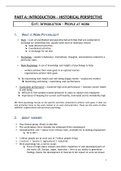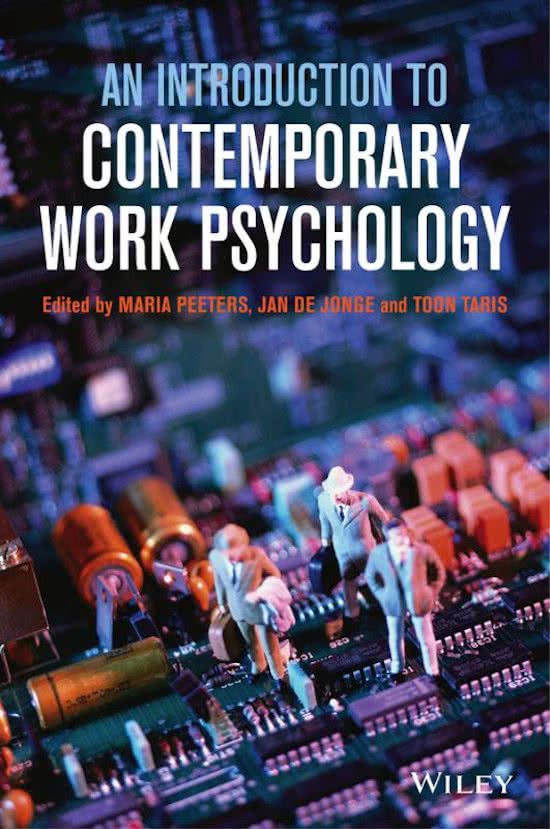PART A: INTRODUCTION – HISTORICAL PERSPECTIVE
CH1: INTRODUCTION – PEOPLE AT WORK
1. WHAT IS WORK PSYCHOLOGY?
Work = a set of coordinated and goal-directed activities that are conducted in
exchange for something else, usually some form of monetary reward
Goal-directed activities
Coordinated activities
In exchange for sth else
Psychology = people’s behaviour, motivations, thoughts, and emotions related to a
particular topic.
Work Psychology use of knowledge and insights of psychology to help:
- workers achieve their work goals in an optimal manner
- organizations achieve their goals
By maximising work health and well-being (happy worker = productive worker)
Maximising well-being = maximising work performance
Sustainable performance = maximize high work performance + maintain worker health
& well-being
Difficult to find suitable trained personnel & costly to replace sick employees
Importance of keeping the current staff healthy, motivated and its workability high
NB: Work psychology focuses on the specific activities conducted to achieve work goals. It does not
(not primarily) focus on the work context or on work characteristics. These are the works of other
subfields: organizational and personnel psychology.
2. ABOUT WORKERS
Very diverse group hard to describe
The world labour force includes the employed & the unemployed
Unemployment rate = labour force without work, available for & seeking employment
6% in 2011
3 billion people are at work (out of 7 billion people living)
3 sectors: 1. Service 2. Agricultural 3. Industrial.
Work psychology has a narrow scope:
Focus on high-status workers and ethnic majorities in well-developed parts of
the world (US, Europe, Japan, Australia) > limit to our ability to generalize
findings, blocks the development of theories & full impact of work not known
1
,3. THE MEANING OF WORKING
Sustainable work performance is not enough many workers do not enjoy their work and
only do it for the money they need to subsist.
One way of understanding the meaning of working to people:
Cultural artefacts = popular songs, books, movies, and paintings that reflect the
real cultural and societal values and attitudes of the population towards work; what
they think of it and what place it has in their lives.
Popular songs and shows frequently depicts work and working life as something
unpleasant & may have adverse consequences on health and well-being.
>< Research has proven that people do not only work for money, but it serves other
functions Having a job contributes to health & well-being, this is when compared to
being unemployed. Why is being unemployed yielding so many negative consequences?
Marie Jahoda’s Relative Deprivation Theory has shown that the reasons why
working brings positive consequences is because it provides 5 classes of social
benefits:
Time structure
Opportunities for social contact
Sharing of a common purpose
Social identity/social status
Regular activity
Being unemployed is thus being deprived of all five benefits in addition to a low income
(meaning not a lot is spent on activities and goods outside the bare necessities).
“Work is hell- but it beats unemployment” – Matt Groening (1987)
4. ROOTS OF WORK PSYCHOLOGY
Before work psychology focused on sustainable performance, the emphasis was put on the
best way to make organizations work (+ most profit & productivity) = industrial capitalism
(mid-19th century).
Systematic thinking about the organization of work
Scholars have long thought systematically about the best way of conducting work tasks.
Ex: the Roman army used military manuals that showed how soldiers should conduct their
tasks, and medical doctors in Ancient Greece worked according to the routines &
guidelines documented in the books of the Hippocratic collection.
The birth of occupational medicine
In the early 1500s, the first truly scientific texts on the association between work and
health appeared. Agricola documented the impact of working in mines on the health and
well-being of miners. Later on, Ramazzini extended this work to include no less than 52
occupations. These books constituted the starting point for the discipline now known as
occupational medicine.
Work psychology 1850-1930
2
,The industrial revolution marked a transition to new manufacturing processes:
mechanization (i.e., steam power) & industrialization (artisanal mass production).
These changes affected the shape of employment of the masses and reformed the
economic system into that of industrial capitalism. Even if there was an increase in job
opportunities, a major issue in work concerned the productivity of the workers. Psycho-
technics or applied psychology, introduced in Germany at the end of the 19 th century,
applied psychological insights in the branch of personnel psychology that focuses on the
link between workers’ characteristics and job requirements.
more well-being & productivity when the job fits the worker
Scientific management (Taylorism)
Introduced and popularized by F. Taylor. He had 2 assumptions: workers are lazy & stupid
focus on the simplification and optimization of tasks and the increase of work motivation
by the introduction of strict supervision and pay-for-performance systems.
Goal = maximize industrial efficiency
How? By analysing tasks thoroughly and systematically + the best trained the others + use
of photography & movies (Frank & Lillian Gilbreth – analysis of work motions ergonomics)
Work psychology 1930-present
Popularity of scientific management grew till the mid 1930’s. Work was repetitive, boring
& physically demanding worker morale was affected negatively + more conflicts between
workers & employers + more labour unions & recurring strikes.
The human relations movement
Roots of modern work psychology
After 1930, the popularity of Taylor's ideas waned, and were replaced by the insights of
the human relations movement. Based on experiments conducted in General Electric's
Hawthorne plant, this school of thought focused particularly on the social context in which
the work tasks were conducted.
special attention to the human side of the job
To promote worker commitment and discourage worker turnover and unionization, the
human relations movement focused on the well-being of the workers (introduction of
pensions, sick pay, stock purchase plans + educational & recreational programmes).
Experiments were conducted to examine the effects of contextual factors on worker
productivity. The findings were inconclusive but still influential for the field. Being a team
and building relationships over time at work was the main driver of increased productivity.
Contemporary work psychology
Contemporary work psychology promotes sustainable performance Aims to:
3
, - improve productivity by optimizing the organization of work, work methods & job
characteristics
- maximize worker health and well-being
5. CHANGES IN WORK & WORK ORGANIZATION
Major change in the mid-20th century due to technological advances & economic trends.
The changing nature of work
The nature of work has changed from manufacturing work to service & knowledge work.
1. Increase in service sector Less physically strenuous jobs with less exposure to physical
health risks New demands: emotion labour Service organizations rely on their
customers ‘Service with a smile’ = job requirement
2. Decline in manufacturing sector Jobs made easier with the help of new technologies
Jobs less labour-intensive
3. ‘Knowledge worker’ rapid growing segment of the workforce
= highly educated employee, applies theoretical and analytical knowledge to developing
new products & services.
The changing workforce
The workforce has become more diverse in terms of gender, age, ethnicity, organizational
tenure, and educational background.
Major impact on creating new territories for research & practice in work psychology.
The changing flexibility of working
New ways of working are characterized by:
(1) flexibility in the timing of work: workers have + autonomy in deciding when they work
(2) flexibility in the place of work: workers can work from home/at the office / train…
(3) facilitation of information/ new media technologies: smartphones & videoconferencing
‘Virtual teams’ are born: work with others having different schedules & locations
The changing organization
Organizations are bound to undertake ongoing changes and must continuously adapt to new
realities. 2 major trends responsible for it:
a) Globalization: changes the environments & markets in which the org. has to operate
b) Increasing use of ICT (Information & Communication Technology): redefines how, when
& where work is performed.
The changing psychological contract (what employees & employers want and expect
from each other)
4






